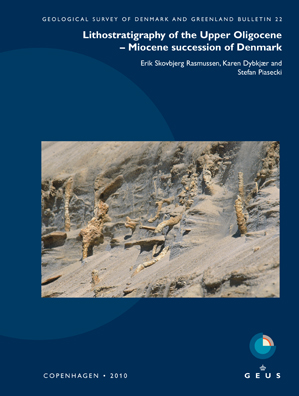
How to Cite
Share
Abstract
This paper presents a revised lithostratigraphic scheme for the uppermost Upper Oligocene – Miocene succession of Denmark. The marine Oligocene Brejning Clay Member is upgraded to formation status and includes the Sydklint Member and the Øksenrade Member (new). The shallow marine and deltaic deposits of mainly Early Miocene age are included in the Ribe Group (new) while the fully marine Middle and Upper Miocene clay-rich deposits are referred to the Måde Group (new). The Ribe Group is subdivided into 6 formations: the Vejle Fjord Formation is revised and includes the Skansebakke Member, the Billund Formation (new) includes the Addit and Hvidbjerg Members (new), the Klintinghoved Formation is redefined formally and includes the Koldingfjord Member (new), the Bastrup Formation (new) includes the Resen Member (new), the Vandel Member is a new member in the Arnum Formation (revised), the Odderup Formation is redefined and includes the Stauning Member (new) and the coalbearing Fasterholt Member. The Måde Group is subdivided into the Hodde, Ørnhøj (new), Gram and Marbæk (new) Formations. Subdivision of the Upper Oligocene – Miocene succession into two groups, the Ribe and Måde Groups, is compatible with the North Sea lithostratigraphic framework where they correlate with the upper part of the Hordaland Group and the Nordland Group, respectively.
The revised lithostratigraphic framework correlated in three dimensions provides rigorous constraints on the palaeogeographic interpretation of the Late Oligocene – Miocene period. Three major deltaic units (Billund, Bastrup and Odderup Formations) prograded from the north and north-east into the North Sea Basin during the Early – early Middle Miocene. Delta progradation was punctuated by deposition of marine clay and silt associated with minor transgressive events (Vejle Fjord, Klintinghoved and Arnum Formations). During the Middle–Late Miocene, marine depositional conditions dominated (Hodde, Ørnhøj and Gram Formations). A fourth and final progadational event (Marbæk Formation) commenced in the latest Tortonian heralding the emergence of present-day Denmark (including the North Sea sector).
How to Cite
Share
Copyright (c) 2010 Erik Skovbjerg Rasmussen, Karen Dybkjær, Stefan Piasecki

This work is licensed under a Creative Commons Attribution 4.0 International License.
Downloads
Erik Skovbjerg Rasmussen, Karen Dybkjær and Stefan Piasecki
The Upper Oligocene – Miocene succession of onshore Denmark is about 250 m thick and is composed of interdigitating, coarse-grained fluvio-deltaic and mud-rich marine sediments; it is best exposed in coastal cliffs in eastern and northern Jylland but is also seen locally inland. [...]









